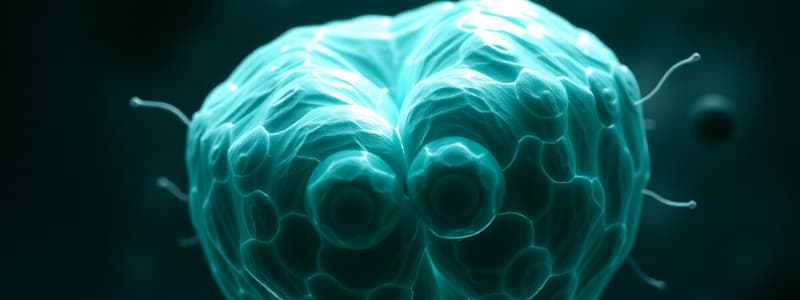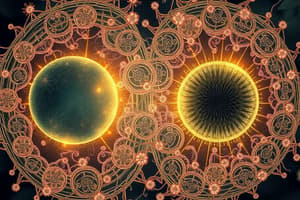Podcast
Questions and Answers
What is the function of the cell plate in plant cells during cell division?
What is the function of the cell plate in plant cells during cell division?
- To transport nutrients between daughter cells
- To form a new cell wall that separates daughter cells (correct)
- To replicate the genetic material of the cell
- To absorb sunlight for photosynthesis
What does the term 'haploid' refer to in terms of chromosome sets?
What does the term 'haploid' refer to in terms of chromosome sets?
- A cell that has lost half of its chromosomes
- A cell with two sets of chromosomes
- A cell undergoing meiosis
- A cell with one set of chromosomes (correct)
What is formed when the nuclei of male and female gametes fuse during fertilization?
What is formed when the nuclei of male and female gametes fuse during fertilization?
- A mature gamete
- A diploid cell
- A zygote (correct)
- A haploid egg
Where does meiosis occur in humans?
Where does meiosis occur in humans?
What is the result of meiosis in terms of chromosome number?
What is the result of meiosis in terms of chromosome number?
Which of the following describes binary fission?
Which of the following describes binary fission?
What is the longest phase of the cell cycle?
What is the longest phase of the cell cycle?
During which phase does DNA replication occur?
During which phase does DNA replication occur?
What are sister chromatids?
What are sister chromatids?
Which process is responsible for cell division in prokaryotic cells?
Which process is responsible for cell division in prokaryotic cells?
What role does the centromere play during cell division?
What role does the centromere play during cell division?
Which phase of the cell cycle includes cell growth and functions aside from division?
Which phase of the cell cycle includes cell growth and functions aside from division?
What is the primary function of mitosis?
What is the primary function of mitosis?
What is the result of each homologous chromosome moving to an opposite pole during anaphase I?
What is the result of each homologous chromosome moving to an opposite pole during anaphase I?
Which phase of meiosis involves the formation of gametes from the resulting daughter cells?
Which phase of meiosis involves the formation of gametes from the resulting daughter cells?
What is one significant difference between spermatogenesis and oogenesis?
What is one significant difference between spermatogenesis and oogenesis?
How many possible orientations can chromosomes have during meiosis due to the 23 pairs of homologous chromosomes in humans?
How many possible orientations can chromosomes have during meiosis due to the 23 pairs of homologous chromosomes in humans?
What marks the beginning of cytokinesis during meiosis?
What marks the beginning of cytokinesis during meiosis?
What is the primary purpose of meiosis?
What is the primary purpose of meiosis?
During which phase of meiosis does crossing-over occur?
During which phase of meiosis does crossing-over occur?
Which of the following statements about meiotic division is true?
Which of the following statements about meiotic division is true?
What occurs during random assortment in meiosis?
What occurs during random assortment in meiosis?
What type of cell undergoes meiosis?
What type of cell undergoes meiosis?
What is the outcome of meiosis II?
What is the outcome of meiosis II?
Which phase occurs first during meiosis?
Which phase occurs first during meiosis?
What role does crossing-over play in meiosis?
What role does crossing-over play in meiosis?
During which phase do the chromosomes align at the equatorial plane?
During which phase do the chromosomes align at the equatorial plane?
What happens to the chromatids during anaphase?
What happens to the chromatids during anaphase?
What structure forms during prophase and is essential for chromosome movement?
What structure forms during prophase and is essential for chromosome movement?
What is the result of cytokinesis in animal cells?
What is the result of cytokinesis in animal cells?
What occurs during telophase?
What occurs during telophase?
Which structure is responsible for pinching the cell into two during cytokinesis in animal cells?
Which structure is responsible for pinching the cell into two during cytokinesis in animal cells?
What happens to the nuclear membrane during prophase of mitosis?
What happens to the nuclear membrane during prophase of mitosis?
How do centrosomes behave during mitosis?
How do centrosomes behave during mitosis?
What is formed at the end of mitosis?
What is formed at the end of mitosis?
Flashcards
Binary Fission
Binary Fission
The simplest and fastest way for prokaryotic cells to reproduce, where the parent cell divides into two equal daughter cells.
Mitosis
Mitosis
A type of cell division that produces two identical daughter cells from a single parent cell in eukaryotic organisms.
Cell Cycle
Cell Cycle
The repeating set of events that make up the life of a cell, from its formation to its division into two cells.
Interphase
Interphase
Signup and view all the flashcards
S phase
S phase
Signup and view all the flashcards
Sister Chromatids
Sister Chromatids
Signup and view all the flashcards
Chromosome
Chromosome
Signup and view all the flashcards
Centromere
Centromere
Signup and view all the flashcards
Metaphase
Metaphase
Signup and view all the flashcards
Telophase
Telophase
Signup and view all the flashcards
Cytokinesis
Cytokinesis
Signup and view all the flashcards
Chromatin
Chromatin
Signup and view all the flashcards
Spindle fibers
Spindle fibers
Signup and view all the flashcards
What is a chromosome set?
What is a chromosome set?
Signup and view all the flashcards
Haploid vs. Diploid
Haploid vs. Diploid
Signup and view all the flashcards
Gamete Number
Gamete Number
Signup and view all the flashcards
Fertilization
Fertilization
Signup and view all the flashcards
What happens in telophase I?
What happens in telophase I?
Signup and view all the flashcards
What is the result of meiosis II?
What is the result of meiosis II?
Signup and view all the flashcards
How is spermatogenesis different from oogenesis?
How is spermatogenesis different from oogenesis?
Signup and view all the flashcards
Anaphase I: What happens to the chromosomes?
Anaphase I: What happens to the chromosomes?
Signup and view all the flashcards
Why are there so many possible chromosome combinations?
Why are there so many possible chromosome combinations?
Signup and view all the flashcards
What does meiosis do to chromosomes?
What does meiosis do to chromosomes?
Signup and view all the flashcards
How many cells does meiosis produce?
How many cells does meiosis produce?
Signup and view all the flashcards
Why is meiosis important for sexual reproduction?
Why is meiosis important for sexual reproduction?
Signup and view all the flashcards
Where does meiosis occur?
Where does meiosis occur?
Signup and view all the flashcards
When does crossing-over occur?
When does crossing-over occur?
Signup and view all the flashcards
What is random assortment?
What is random assortment?
Signup and view all the flashcards
What's the purpose of crossing-over and random assortment?
What's the purpose of crossing-over and random assortment?
Signup and view all the flashcards
What is meiosis II?
What is meiosis II?
Signup and view all the flashcards
Study Notes
Cell Cycle and Mitosis
- Kinds of cell division:
- Binary fission (prokaryotic cells)
- Mitosis (eukaryotic cells)
- Meiosis (eukaryotic cells)
Binary Fission
- Simplest and fastest form of reproduction in prokaryotes
- Parent cell divides into two daughter cells of roughly equal size
- Steps: DNA replication, cell elongation, formation of cell wall between chromosomes, cell splitting
Cell Division in Eukaryotic Cells
- Cell cycle: repeating set of events from formation to division
- Interphase (90% of cell cycle): time between divisions; growth, DNA replication, cell functions
- Phases of interphase: G1 (growth), S (DNA synthesis), G2 (preparation for division).
- Mitosis/Meiosis (10% of cell cycle)
Mitosis
- Cell division for growth and repair
- Two identical daughter cells resulting from one parent cell
- Four main phases: Prophase, Metaphase, Anaphase, Telophase
Interphase
- Period between cell divisions
- Consists of G1, S, and G2 phases
- Growth, DNA replication, and preparation for cell division occur during interphase.
Chromosome Structure
- Chromosomes are structures containing DNA.
- DNA is coiled around proteins.
- DNA replicates (copies itself). In S phase, each chromosome becomes two sister chromatids joined together by a centromere.
- Two identical copies of a chromosome are called 'sister chromatids'.
Stages of Mitosis
- Prophase: Chromosomes condense, spindle fibers form, and the nuclear envelope breaks down.
- Metaphase: Chromosomes line up in the middle of the cell.
- Anaphase: Sister chromatids separate and move to opposite poles of the cell.
- Telophase: Chromosomes decondense, nuclear envelopes reform, and the cell begins to divide.
Cytokinesis
- Cytokinesis is the division of the cytoplasm to form two separate daughter cells. In animal cells this is a cleavage furrow; in plant cells it's a cell plate.
Meiosis
- Cell division that produces gametes (sperm and egg cells)
- Key feature: reduces chromosome number from diploid (2n) to haploid (1n)
- Two rounds of division (meiosis I and meiosis II)
- Each offspring cell has half the chromosome number as the parent cell
Meiosis I
- Prophase I: Homologous chromosomes pair up and exchange segments (crossing over).
- Metaphase I: Homologous chromosome pairs line up at the cell's equator.
- Anaphase I: Homologous chromosomes separate and move to opposite poles.
- Telophase I: Chromosomes arrive at poles; two haploid cells are formed.
Meiosis II
- Prophase II: Chromosomes condense in each of the two newly formed cells.
- Metaphase II: Chromosomes line up at cell equator.
- Anaphase II: Sister chromatids separate and move to opposite poles.
- Telophase II: Chromosomes arrive at poles; four haploid cells are formed; cytokinesis completes meiosis.
Differences Between Mitosis and Meiosis
- Mitosis creates two diploid cells, meiosis creates four haploid cells.
- Mitosis is involved in growth and repair, meiosis is for sexual reproduction.
Studying That Suits You
Use AI to generate personalized quizzes and flashcards to suit your learning preferences.




